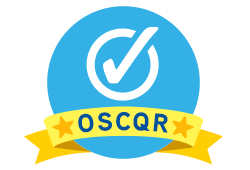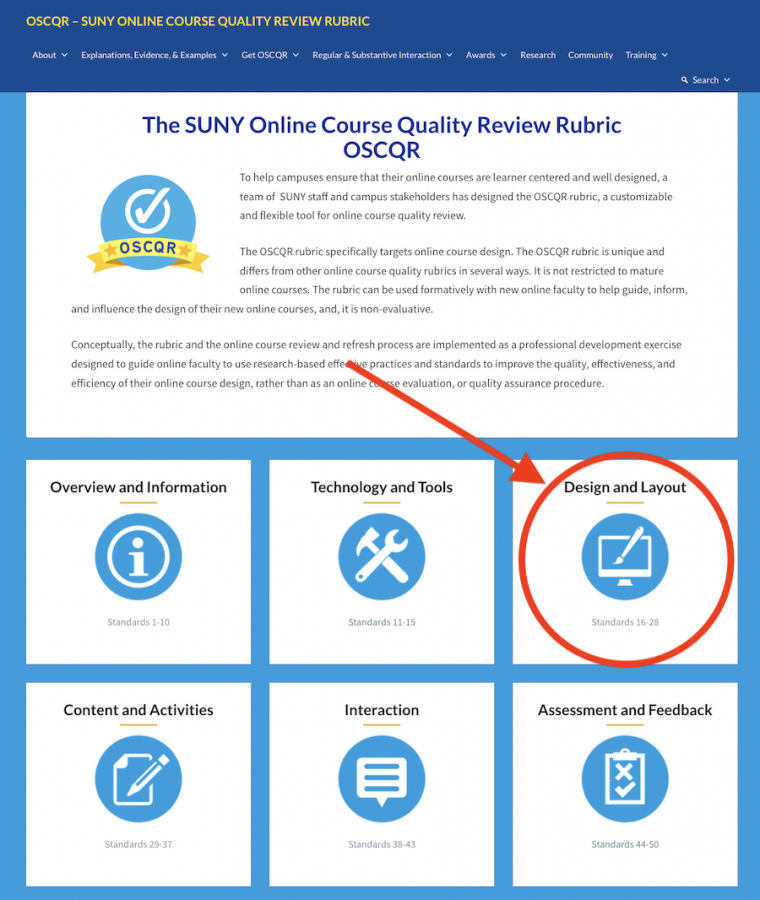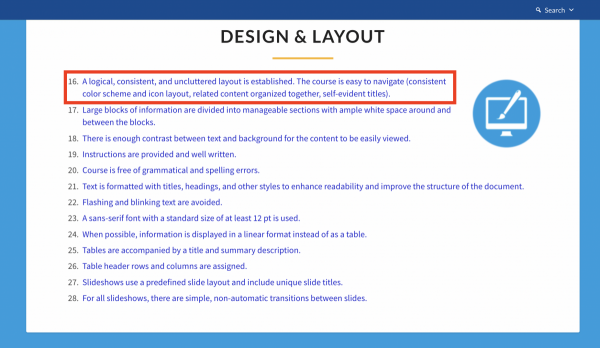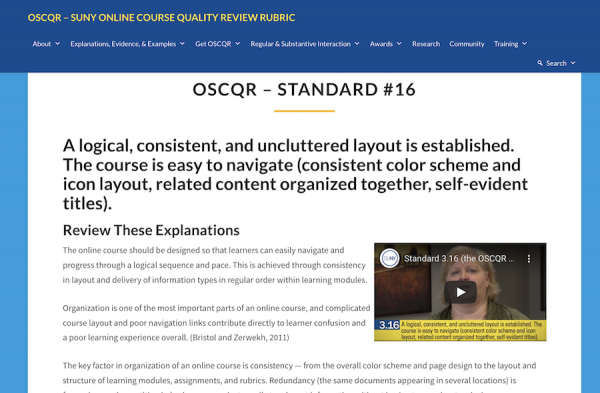OSCQR
What is OSCQR and how does it relate to course development?
 "The Open SUNY Course Quality Review Rubric (OSCQR) is a guide that specifically targets online course design. The OSCQR rubric is unique and differs from other online course quality rubrics in several ways. It is not restricted to mature online courses. The rubric can be used formatively with new online faculty to help guide, inform, and influence the design of their new online courses, and, it is non-evaluative."
"The Open SUNY Course Quality Review Rubric (OSCQR) is a guide that specifically targets online course design. The OSCQR rubric is unique and differs from other online course quality rubrics in several ways. It is not restricted to mature online courses. The rubric can be used formatively with new online faculty to help guide, inform, and influence the design of their new online courses, and, it is non-evaluative."
- Open SUNY Course Quality Review, 2022
OSCQR uses research-based effective practices and standards to guide faculty to improve the quality, effectiveness, and efficiency of their online course design, At Lane, we use OSCQR as a course development guide.
Related tutorials and resources: OSCQR, Universal Design for Learning Guidelines
Using OSCQR
The rubric is meant to be used as a guide and a resource tool. There are 50 standards that are broken down into six major categories:
Accessibility is not considered a separate category in the OSCQR rubric. It is a part of Universal Design for Learning (UDL) and is included as a normal part of course development.
Tip: Remember, OSCQR is a reference guide. It is not intended for you to try and meet each standard. You choose areas that you need to learn more about or to reaffirm that you’re on the right path.
(Click on the plus sign  for more information on a topic)
for more information on a topic)
Universal Design for Learning
Universal design means building a course that includes opportunities for everyone to participate and learn. When designing your course, you want to consider the different ways that students will access materials, and engage in course activities and assessments.
The Universal Design for Learning (UDL) framework is based on the following principles.
- Multiple means of representation—to give learners various ways of acquiring information and knowledge,
- Multiple means of expression —to provide learners alternatives for demonstrating what they know, and
- Multiple means of engagement— to tap into learners' interests, challenge them appropriately, and motivate them to learn
(This framework was developed by The Center for Applied Special Technology (CAST) at Harvard Graduate School of Education in the 1990s.)
Using OSCQR as our guide, we can help you build classes that incorporate universal design principles throughout, making the learning experience more equitable, inclusive and accessible. Contact us at idservices@lanecc.edu for more information.
Additional Resources
Universal Design for Learning Guidelines, The Center for Applied Special Technology
How to Use OSCQR
- Access the Open SUNY Course Quality Review Rubric (OSCQR).
- Choose the category you are interested in learning more about by clicking inside the category box. In the example below the Design and Layout category is being accessed.

- Review all of the standards listed for the category and choose a standard you are interested in learning more about. You’ll be surprised at how many standards you are already implementing in your teaching practices.
In the example below Standard #16 is accessed.
Standard 16. A logical, consistent, and uncluttered layout is established. The course is easy to navigate (consistent color scheme and icon layout, related content organized together, self-evident titles).

- Each standard’s page will give you information about the particular standard. The information includes:
- The full standard
- Review these explanations–Why this standard is important
- Teacher testimonial–A short video interview with an instructor on why and how they incorporate the standard into their teaching practices
- Refresh Your Course with These Ideas–Suggestions on how to incorporate the standard into your teaching practices
- Supplemental information includes resources and sharing

Contact ID services if you need more information on how to incorporate these standards into your course.
Discover | Design | Develop | Deliver/Improve | Workshops & Training | Accessibility | Contact Us
Contact ID Services at idservices@lanecc.edu | Contact the ATC at ATC@lanecc.edu
Icons created by Freepik - Flaticon unless noted otherwise.
 "The Open SUNY Course Quality Review Rubric (OSCQR) is a guide that specifically targets online course design. The OSCQR rubric is unique and differs from other online course quality rubrics in several ways. It is not restricted to mature online courses. The rubric can be used formatively with new online faculty to help guide, inform, and influence the design of their new online courses, and, it is non-evaluative."
"The Open SUNY Course Quality Review Rubric (OSCQR) is a guide that specifically targets online course design. The OSCQR rubric is unique and differs from other online course quality rubrics in several ways. It is not restricted to mature online courses. The rubric can be used formatively with new online faculty to help guide, inform, and influence the design of their new online courses, and, it is non-evaluative."![]() for more information on a topic)
for more information on a topic)


